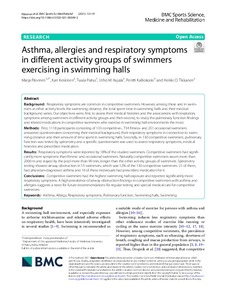Asthma, allergies and respiratory symptoms in different activity groups of swimmers exercising in swimming halls
Kalliokoski Pentti; Tikkanen Heikki O.; Kujala Urho M.; Päivinen Marja; Keskinen Kari; Putus Tuula
https://urn.fi/URN:NBN:fi-fe2021120158367
Tiivistelmä
Background: Respiratory symptoms are common in competitive swimmers. However, among these and in swimmers at other activity levels the swimming distance, the total spent time in swimming halls and their medical background varies. Our objectives were, first, to assess their medical histories and the associations with respiratory symptoms among swimmers in different activity groups and then second, to study the pulmonary function findings and related medications in competitive swimmers who exercise in swimming hall environments the most.
Methods: First, 1118 participants consisting of 133 competitive-, 734 fitness- and 251 occasional swimmers answered questionnaires concerning their medical background, their respiratory symptoms in connection to swimming distance and their amount of time spent in swimming halls. Secondly, in 130 competitive swimmers, pulmonary function was tested by spirometry and a specific questionnaire was used to assess respiratory symptoms, medical histories and prescribed medication.
Results: Respiratory symptoms were reported by 18% of the studied swimmers. Competitive swimmers had significantly more symptoms than fitness- and occasional swimmers. Naturally competitive swimmers swum more than 2000 m and stayed by the pool more than 90 min, longer than the other activity groups of swimmers. Spirometry testing showed airway obstruction in 15 swimmers, which was 12% of the 130 competitive swimmers. 21 of them, had physician-diagnosed asthma and 16 of these individuals had prescribed medication for it.
Conclusions: Competitive swimmers had the highest swimming hall exposure and reported significantly more respiratory symptoms. A high prevalence of airway obstruction findings in competitive swimmers with asthma and allergies suggests a need for future recommendations for regular testing and special medical care for competitive swimmers.
Kokoelmat
- Rinnakkaistallenteet [19207]
